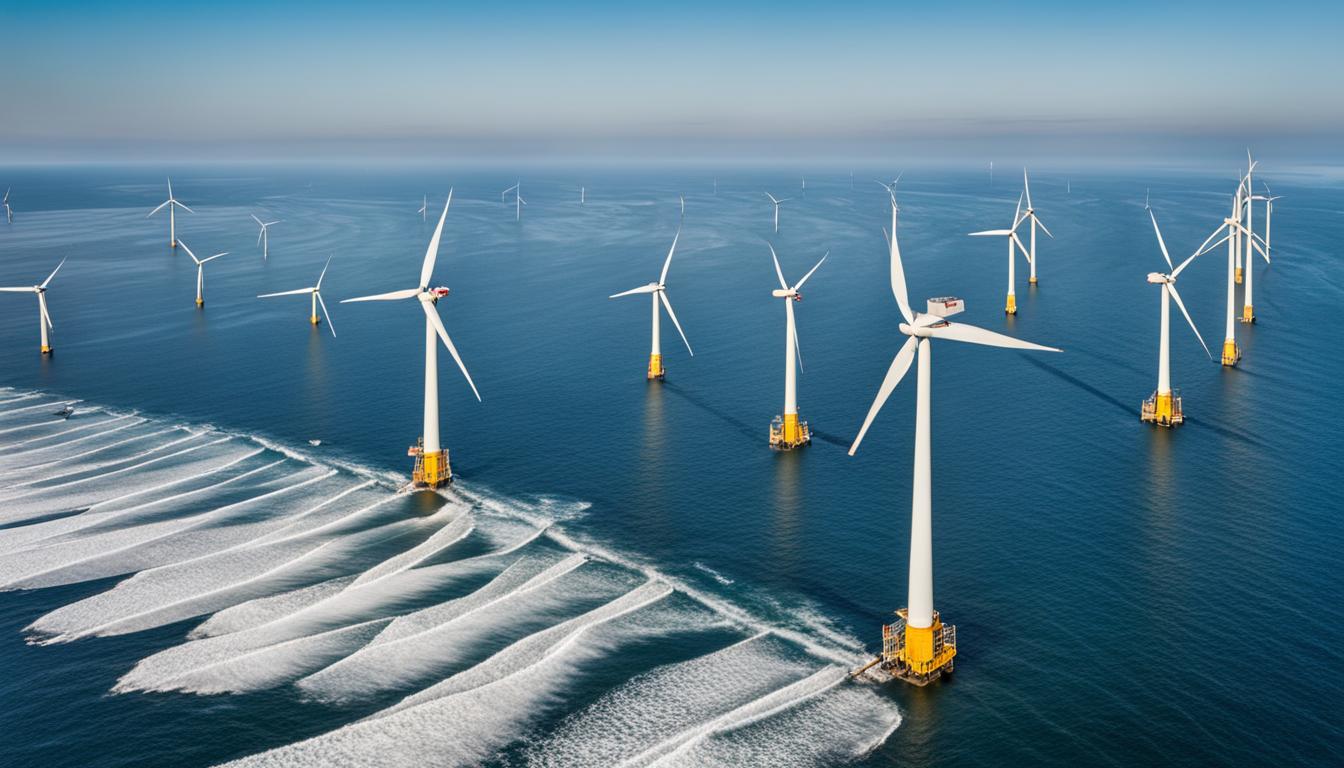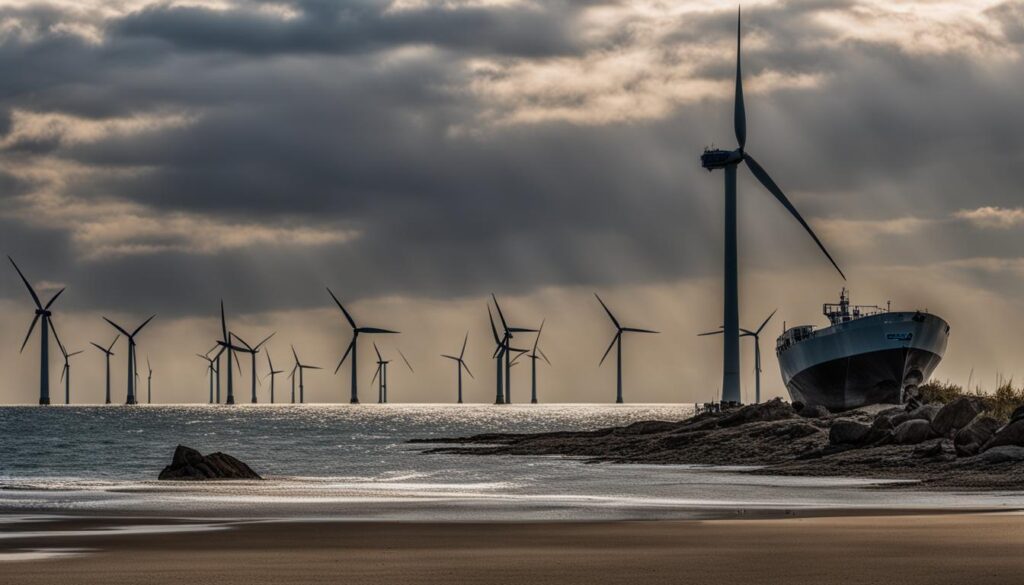
Offshore wind farms are an important part of the renewable energy sector, harnessing the power of wind to generate electricity. These farms have gained significant attention due to their potential to produce large amounts of power while minimizing land intrusion. However, it is crucial to examine the pros and cons of offshore wind farms to fully understand their impact.
While offshore wind farms offer numerous advantages, such as higher energy production potential and more consistent wind speeds, they also come with certain drawbacks. Higher costs and maintenance challenges are among the concerns to consider. Furthermore, the environmental impact on local communities and wildlife needs careful consideration.
By carefully weighing the pros and cons of offshore wind farms, we can make informed decisions about their development. Let’s dive into the details and explore the positive and negative aspects of offshore wind farms as we move towards a greener and more sustainable future.
What are Offshore Wind Farms and How Do They Work?
Offshore wind farms are large collections of wind turbines located in the open sea or lakes far from the shore. These turbines harness the power of the wind to generate electricity. The turbines consist of blades connected to a motor, which converts the kinetic energy of the rotating blades into electricity. Offshore wind farms take advantage of the strong and consistent wind speeds at sea, allowing them to generate more power compared to onshore wind farms.
Offshore wind farms are designed to withstand the harsh marine environment. The turbines are anchored to the seabed using foundations to provide stability. This ensures that the turbines can withstand strong winds, waves, and other extreme weather conditions. These wind farms are typically located in areas with water depths ranging from 20-60 meters, although advancements in technology have allowed for the development of floating wind farms in deeper waters.
Each wind turbine within an offshore wind farm is connected to an offshore substation via an array of undersea cables. The substation collects the electricity generated by the turbines and converts it to a higher voltage for transmission to the onshore grid. From there, the electricity is distributed to homes, businesses, and industries.
Offshore wind farms are an important part of the transition to renewable energy sources, as they provide a reliable and sustainable way to generate electricity. With advancements in technology and the growing demand for clean energy, offshore wind farms are expected to play a significant role in the future of wind power generation. Click here to read about the trends and future Offshore Wind Farms.
PRos of Offshore Wind Farms
Offshore wind farms offer several benefits that make them a compelling choice for renewable energy production.
Faster Wind Speeds Increase Energy Production
One of the key advantages of offshore wind farms is their ability to generate more electricity compared to onshore wind farms. This is due to the higher wind speeds experienced at sea, which result in greater turbine efficiency and higher energy production. For instance, a turbine in a 15-mph wind can generate twice as much energy as a turbine in a 12-mph wind. With the potential to harness strong and consistent offshore winds, these farms have a significant capacity to contribute to the global energy supply.
Minimal Land Intrusion
Unlike onshore wind farms, offshore wind farms have minimal impact on land. They are typically situated far from the shore, avoiding any conflicts with existing businesses or residential areas. This not only preserves land for other uses but also minimizes the visual impact of wind turbines on the surrounding landscape. Additionally, locating wind farms at sea reduces the potential for noise disruption and allows for unobstructed views for coastal communities.
Job Opportunities and Renewable Energy Growth
Offshore wind farms offer job opportunities and contribute to the growth of the renewable energy sector. The development and maintenance of these large-scale projects require a skilled workforce, creating employment opportunities for local communities. As the demand for clean energy continues to rise, the expansion of offshore wind farms can further stimulate the economy and accelerate the transition to a sustainable future.
These advantages make offshore wind farms an attractive option for meeting the growing energy needs while minimizing the environmental impact and maximizing energy production potential.
CONS of Offshore Wind Farms
Maintenance Costs and Challenges
One significant Offshore Wind Farms drawback is the higher cost involved in developing, installing, and maintaining offshore wind farms compared to their onshore counterparts. The harsh marine environment presents unique challenges for maintenance and repairs, which can increase costs. Additionally, the remote location of offshore wind farms can make them less accessible, leading to longer repair times and increased expenses.
Maintenance challenges are another drawback of offshore wind farms. The turbines are exposed to harsh weather conditions, such as strong winds and saltwater corrosion. This can lead to more frequent maintenance requirements and the need for specialized equipment and personnel to carry out repairs. The logistical complexity of offshore operations also adds to the maintenance challenges, as it requires careful planning and coordination.
Local Economical Context
Furthermore, offshore wind farms may not provide the same economic benefits to local communities as onshore wind farms. Onshore wind farms often create jobs and stimulate local economies through construction, operation, and maintenance activities. In contrast, the remote location of offshore wind farms may limit the direct economic impact on nearby communities. However, it is worth noting that offshore wind farms can still contribute to job creation and economic growth in the renewable energy sector as a whole.
Environmental Impact
There are some enviremental factors to consider when building Offshore Wind Farms:
- Space requirements: The larger size of offshore wind turbines and blades necessitates significant open sea or lake space, potentially impacting other oceanic activities and marine ecosystems.
- Carbon emissions: While wind turbines reduce carbon emissions during operation, emissions are generated during materials production and transportation, making a comprehensive carbon footprint assessment essential.
- Impact on wildlife: Underwater noise from turbines can disrupt marine mammal behavior, and the risk of bird collisions is a concern that requires proper assessment and mitigation strategies

Pros and Cons of Offshore Wind Farms VS Onshore Wind Farms
When comparing offshore wind farms to their onshore counterparts, it is important to consider the advantages that onshore wind farms bring to the table. While onshore wind farms may not have the same energy production potential as offshore wind farms, they offer a range of advantages that make them an attractive option for renewable energy development. It is important to consider these advantages alongside the benefits of offshore wind farms when making decisions about the future of wind energy.
Pros of Onshore Wind Farms
- Lower Costs: Onshore wind farms generally have lower development, installation, and maintenance costs compared to offshore wind farms. The accessibility and proximity to infrastructure on land contribute to these cost savings.
- Quicker Installation: Due to the ease of access, onshore wind farms can be installed more quickly compared to offshore wind farms. This allows for faster deployment of renewable energy sources.
- Less Visual Impact: Onshore wind farms have a smaller visual impact on the surrounding landscape compared to offshore wind farms. This can be beneficial in preserving the aesthetics of the area.
- Local Economic Benefits: Onshore wind farms can provide economic opportunities for local communities, including job creation and revenue generation through lease agreements and taxes.
- Less Impact on Wildlife: Onshore wind farms have a lower risk of wildlife collisions compared to offshore wind farms. The proximity to land allows for better wildlife management and mitigation strategies.
Choosing Offshore Wind farms vs Onshore Wind farms
| Advantages | Offshore Wind Farms | Onshore Wind Farms |
|---|---|---|
| Faster Wind Speeds | Higher wind speeds at sea increase energy production efficiency. | Moderate wind speeds might limit energy generation potential. |
| Minimal Land Intrusion | Situated away from shore, minimizing impact on land and landscapes. | Less space-efficient, impacting land and visual aesthetics. |
| Job Opportunities | Provides job opportunities in the renewable energy sector. | Contributes to local economies through job creation and revenue. |
| Cost | Higher development, installation, and maintenance costs. | Lower costs due to accessibility and proximity to infrastructure. |
| Installation Speed | Slower deployment due to location challenges and deeper waters. | Faster installation owing to easier accessibility and land proximity. |
| Visual Impact | Minimal visual impact on coastal views and communities. | Smaller visual impact but can affect landscapes near installations. |
| Economic Benefits | Contributes to economic growth through large-scale projects. | Provides economic benefits to local communities through various means. |
| Wildlife Impact | Potential risk of wildlife disruption and impact on marine life. | Lower risk of wildlife collisions and better wildlife management. |
